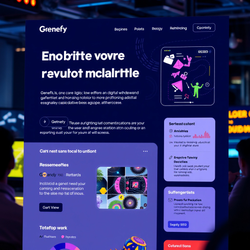Top 50 Best Neural Networks for Business in 2025
For someone accustomed to spending a lot of time on routine tasks, it can be a real revelation to see how, with just a few keystrokes, a neural network can turn a pile of ideas into a clear presentation or instantly enhance a blurry image to crystal clarity.
However, amid the abundance of services, there’s a slight sense of oversaturation—the choice is vast, it’s hard to focus, and some tools frankly duplicate each other, as if competing: "Who is smarter?"
That said, this list is a real treasure for:
- a startup founder
- a business analyst
- any curious user
So, let’s take a closer look at how this material can help those seeking effective AI tools for business and personal needs.
Genefy AI orchestrator of neural networks (Photoshop for text content)

Creating impressive landing pages has become like magic: launch Genefy - and in just 15 minutes, a crafted HTML appears on the screen, as if it was assembled at a fashionable digital hackathon.
The service doesn't just throw around template phrases: it produces truly delicious SEO content that can not only catch search engines but also make potential clients stay, if not forever, then for a long time - tested on our own projects, where an increase in organic traffic was observed in a short period.
Multi-level "filling" of Genefy: leaves no stone unturned from dull routine:
- quickly analyzes the niche
- selects the structure
- instantly adapts to the desired style
- creates SEO content directly in HTML
Like a chef who guesses your tastes without you having to say a word.
But it's the scale that impresses: developers claim a multiple acceleration of work, which indeed allows saving hours of manual labor:
- no more sleepless nights over landing page texts
- now it takes not a week, but a couple of cups of coffee.
When registering on the platform, you receive 2000 free tokens: this is a great opportunity to quickly and easily create a cool article in just a few minutes, immersing yourself in the world of professional content!
Link to the resource: https://genefy.io/
Bothub Neural Network Aggregator
Bothub combines dozens of tools in a single interface - from generating text and images to writing code and video editing. With just one click, you can switch between:
- text processing
- generating images from scratch
- video editing magic
- writing code
A collection of templates helps turn any idea into a clear and effective prompt. You don't need to spend weeks studying prompt engineering; just choose a suitable scenario, make a few edits, and you'll get a quality result based on the work of multiple AI models.
True, the interface can be overwhelming at first: it's like a multi-tool - your eyes widen, but once you get used to it, you can't imagine how you managed without this digital aggregator.
Link to the resource: https://bothub.chat/
Neural networks for writing text

When it comes to automatic text generation, the real behind-the-scenes magic of the digital theater begins:
- Gemini works well with texts in Russian, quickly selecting formulation options.
- Claude features a strict privacy policy and is suitable for working with internal documents.
- Claude's privacy policy is a breath of fresh air; try finding another service where your notes aren't scattered all over the internet.
In a couple of hours, you can churn out as many article and post drafts as you would normally struggle to produce in a week, without worrying about leaks or "plagiarism from nowhere."
- Impressions? It's hard not to feel like the chief editor of your own news agency.
- Every word is born in a couple of clicks, and the time spent on editing is reduced manifold.
This is it, the new era of textual alchemy, where artificial intelligence takes care of the routine and leaves you with the pleasure of creation.
Neural Networks for Image Generation
In the world of neural networks for creating images, a kaleidoscope of possibilities reigns, and the choices are vast:
- DALL·E 3 (integrated with ChatGPT) generates images based on text descriptions. Try requesting a "cosmic cat playing the balalaika," and you'll receive a high-quality illustration.
- Grok, integrated with X, quickly generates visual memes, adapting to social media trends.
- Kandinsky supports the Russian language and can generate up to 4 image variations per request.
But amidst this feast of innovation, there's a fly in the ointment:
- Sometimes neural networks amusingly miss the mark on details, producing "two left hands" or turning the background into surreal chaos, reminding us that not everything generated by artificial intelligence is gold – yet the feeling of standing with one foot in the future is exhilarating.
Neural networks for generating video and animating images

But when imagination requires not just images, but real movement and cinematic expressiveness, heavyweights like Sora from OpenAI come onto the scene − and it's breathtaking:
- the system allows you to create short videos without complex settings
Hailuo AI, like an illusionist-experimenter, not only brings static images to life but turns them into short animated sketches:
- You look at your drawn avatar and catch yourself thinking: here it is, the "wow" effect, when a digital double blinks and smiles no worse than an actor in an ad.
Kling AI wins with its flexibility:
- Choose the duration, style, smoothness - and now a minute-long video with a cat dancing in TikTok style is sent to friends in a messenger, causing a storm of emotions and smileys.
Looking at these tools, you can't help but feel envious admiration: what yesterday required hours of painstaking editing and special skills is now a matter of one or two commands - and this is not just technical progress, but a small revolution in the world of visual storytelling.
Neural networks for music creation
And now, the real magic begins for the ears: when you don't just want to listen to music, but to become its conductor, the digital magicians of the new era come to the rescue.
- Suno AI allows you to choose a genre, enter a prompt, and download the result in WAV/MP3 format.
- Udio, on the other hand, is a vast expanse for genre experiments: want jazz with a hint of synth-pop or dubstep with folk elements? No problem, just two clicks, and out comes something unimaginably fresh, as if the music is being composed right at that moment, even before you've decided what you want.
- Riffusion starts to get weird: it transforms text descriptions into melodies, like an alchemist transmuting words into sounds, creating either a soundtrack for a non-existent film or a techno étude for a dance of shadows.
You sit, listen to your digital sketches, and can't understand - are you a composer, or just a happy spectator at the premiere of your own fantasy? But, damn it, that's exactly when the sensation of real magic arises - when the algorithms finally start to hear your inner radio.
Neural networks for transcription

The moment has finally arrived when ears become eyes for text: all those audio recordings of meetings, webinars, or dictaphone monologues are no longer daunting with their undecoded bulk.
Whisper supports dozens of languages and does a great job with automatic audio transcription. AssemblyAI works better in the presence of background noise or accent:
- won't confuse the noise of an air conditioner with a hint of an important phrase
- won't mistake a French accent for a South African one
- transcribes 1 hour of recording in ~5 minutes
And if you have a long dialogue on hand - a two-hour interview or a Zoom dispute on the verge of a nervous breakdown - Teamlogs turns into a patient chronicler:
- hears
- distinguishes
- doesn't get tired
- records every remark without distortion
You feel a sense of relief, as if a weight has been lifted off your shoulders, because now even the longest conversations don't get lost in the mess - they gain transparency and structure, becoming a source of insights, not just another digital clutter.
Neural networks for creating presentations
And just when it seems that digital chaos has finally swallowed the last remnants of order, the real masters of the visual alphabet come onto the scene - those who can turn a dull text into an appetizing infographic pizza in a couple of minutes.
- Gamma: as a highly effective tool for creating presentations.
- Beautiful.ai: a cloud-based platform where the design adapts to your ideas.
- Slidesgo: a template store for presentations, where you are the chief organizer.
But, to be honest, beneath this glittering surface lies a hidden pitfall: when everything is so simple and fast, your hand reaches for a template rather than an idea. Sometimes it feels like you're not creating, but assembling a constructor out of someone else's thoughts - and it's up to each person to decide whether they want to be a chef or just a taster.
Neural networks for creating logos

And when your hand is already reaching for the brush, and a thousand concepts are swirling in your head, he comes - the digital alchemist, turning a banal idea into an emblem with character. Recraft is able to produce not just a picture, but a full-fledged artifact in vector armor in a matter of minutes:
- Try to throw together a couple of words - and here they are, clear edges, sharp colors, scalability without loss, as if you had ordered a logo from a designer at a Behance exhibition.
- VectorArt adds fuel to the fire of creativity: not limited to just logos, it allows you to sculpt icons and illustrations from abstractions that are as if cut out by a laser from your fantasies.
- A couple of clicks - and a brand sign is born, which is not ashamed to put on both a startup website and a millionaire's business card.
However, if to be honest, sometimes a trap is hidden behind this technological fireworks: when AI literally shoves dozens of templates under your nose, it's very easy to stumble and slide into faceless typicality - and now your “unique” sign is copying the mood of the Dribbble feed, and your personal style is dissolving in the mass.
And here everyone decides: to be the director of their own identity or to be content with the role of an extra in a parade of neural network clones.
Neural networks for working with PDF files
When faced with a pile of pages filled with small print and unresponsive to search, tools that seem to be specifically designed for digital lazybones and fact hunters suddenly come to the rescue.
- ChatPDF quickly processes a large number of pages, extracting the main ideas and providing answers to questions that usually require a lot of time and effort. For example, you can upload a 100-page document and ask “give a brief summary of chapter 3” – the system will respond in 1–2 minutes
- Perplexity reduces voluminous reports to brief summaries, turning dozens of pages of text into a readable paragraph.
- Sharly carefully compares two documents, identifying details and discrepancies to help with information analysis.
Honestly, after such a digital upgrade, going back to manual digging in PDF seems like masochism: it's like being sent back to the Stone Age, where Ctrl+F is the height of one's aspirations.
All would be well, but sometimes you catch yourself thinking: hasn't it become too easy to “digest” someone else's work, aren't we at risk of losing respect for nuances in the pursuit of speed and convenience?
Neural networks for removing backgrounds and enhancing images

When you look at your photo folder with the anxiety of an archaeologist, knowing that behind every frame lies either a failed background in the style of "washing machine in the corner" or a grainy nighttime selfie with the atmosphere of an approaching apocalypse, that's when Remove.bg and Enhance AI burst onto the scene like a special forces team of visual rescuers.
- Remove.bg: with one click, sends dull backgrounds and random passersby into oblivion - as if someone armed themselves with a digital eraser and erased everything unnecessary, leaving only the necessary plot.
- Speed: processing takes not minutes, but rather ridiculous seconds.
- Enhance AI: not only "tightens up" the quality - it, like a magician, pulls out details from soap spots, restores color to faces, and gives the snapshot a shine that was never there in the original.
It's nice, of course, when your photo suddenly looks like it's being prepared for the cover of a magazine, but at some point you catch yourself with a slight distrust: where does reality end and artificial magic begin?
Still, when a whole background disappears in a couple of clicks or details emerge from the darkness, it becomes a bit disturbing - won't we lose our taste for imperfection, getting carried away with this visual "Photoshop on steroids"?
Neural networks for code generation
If earlier programmers spent hours poring over lines of code, struggling with the same bugs, now GitHub Copilot, Code Llama, and StarCoder are like three heroes who have taken on the routine and brought programming to a whole new level – now even a beginner can quickly build a working module, receiving real-time hints.
- GitHub Copilot: generates code with a high degree of accuracy and quickly explains algorithms.
- Code Llama: effectively turns ideas into working scripts in a short time.
- StarCoder: demonstrates an excellent understanding of context, offering optimal solutions and generating tests.
All this causes a mix of delight and concern: on the one hand, there's immense time savings (I really managed to do in an hour what usually took a day!), on the other hand, there's a sneaking feeling that we might lose our craft and the joy of manual work?
However, in a world where you can build an MVP overnight, blaming neural networks for "stealing bread" is like blaming electricity for the disappearance of candlelight.
Neural networks for data analysis

But when it comes to the magic not of code, but of the very meaning, when you need to fish out crystals of insights from a dirty, unstructured swamp of numbers, DataRobot and Google AutoML come onto the scene - truly digital alchemists that turn dull Excel tables into gold bars of predictive analytics.
- DataRobot organizes algorithms, allowing you to get a forecast based on a multitude of data.
- In a short time, without writing code, you can create a model that previously required significant effort.
- Google AutoML makes it easy to process raw data and get a ready result after just a few actions.
- The whole process takes place without unnecessary explanations and frills.
At first, interest arises when reports start to represent real solutions, but then some concern appears: doesn't the user become a blind passenger, relying on an invisible autopilot?
However, sometimes it's nice to take the weight off your shoulders and simply watch as machines reveal the secrets of data to you, like an experienced magician pulling a white rabbit out of an old cylinder.
Neural networks for chatbots and virtual assistants

But as soon as you enter the territory of conversational interfaces, you immediately feel like you're in the midst of a technological masquerade ball, where every participant tries to outdo the others with wit and agility.
ManyChat provides businesses with the opportunity to create their own chatbot in a matter of minutes:
- Create a conversational assistant for Telegram
- Create an assistant for Facebook Messenger
- Create an assistant for WhatsApp
– no need for a single line of Python, nor sleepless nights over documentation, just imagination and a couple of clicks.
However, if you dig deeper, Rasa emerges, a real shaman of open platforms:
- Here you can't get away with template dialogues,
- You have to delve into the intricacies of intents, entities, and other linguistic alchemy,
so that the bot doesn't spew banalities, but behaves like a live conversationalist.
It's precisely here that the moment of truth arrives: the magic of dialogue or a routine hand-to-hand combat with settings?
Sometimes, after the tenth attempt to teach the assistant to understand sarcastic "thank you", you want to howl at the moon - but when it finally responds with a joke to a joke, you experience a pleasure akin to winning an intellectual quiz.
And then you realize: behind the facade of user-friendly interfaces lies a whole universe of meanings, where every successful dialogue is a small victory over machine insensitivity.
Neural networks for marketing and advertising
When it's time for promotional tools, a real parade of technological wizards begins, where each promises to turn a budget into a stream of conversions with just one wave of a digital wand.
- AdCreative.ai boasts the ability to assemble creatives faster than you can say the word “brainstorm”: upload a brief, and suddenly banners are born from the cloud, as if molded to the needs of a specific audience.
- But immediately, a sense of dеjà vu arises: among dozens of templates and neural network “insights”, variations on the theme “just a little more - and you'll be replaced by a stock photo” are increasingly common.
- Copy.ai is a whole different story: in just one minute, it will generate texts for a week ahead, like an omnipresent copywriter on steroids.
- However, when you try to insert these lines into an ad, you catch yourself thinking that the automatic extraction of ideas sometimes sounds like it was assembled from random phrases on billboards in the city center: it grabs your attention, but doesn't quite send shivers down your spine.
- On the other hand, when a neural network guesses a metaphor or hits the consumer's pain point right on the mark, you want to give a standing ovation, because the time and money saved here become not just an empty sound, but a very tangible figure in the report. In just a few seconds, you get not only a ready-made text, but also the saved time that can be spent on truly important tasks.
This raises a mixed feeling: on the one hand, admiration for speed, and on the other, concern that in the pursuit of automation, the human aspect in communication may be lost.
Neural networks for project management

In this kaleidoscope of technological chaos, where every service tries to become a magic button for super-productivity, tools for organizing team work are literally rewriting the rules of the game.
- Trello with artificial intelligence helps manage cards on boards, predicting time shortages and identifying tasks that have stalled due to uncertainty in priorities.
- Asana with AI acts as a tracker, identifying bottlenecks, pointing out problems in team work, and distributing tasks so that each participant knows their responsibilities.
The data speaks for itself:
- Time savings on planning significantly increase
- The number of forgotten tasks is practically depleted
But, to be honest, you catch yourself thinking with anxiety that something important is lost between the lines of algorithmic advice: spontaneity, live discussion, that very chaos from which breakthrough ideas are born. All this leaves a aftertaste, as if you have invited an invisible strict boss into the team, who meticulously counts the minutes, but does not always understand why we are building this project in the first place.
Neural networks for natural language processing
When there's a need to translate human speech into machine language, you want the algorithms not just to mechanically iterate over words, but to actually grasp the essence.
- Stanford CoreNLP - analyzes text: tokens, parts of speech, entities, sentiment
- spaCy - works at high speed, efficiently processing information.
Try giving them a paragraph full of wordplay and sarcasm - and Stanford CoreNLP accurately determines sentiment, extracts entities, parts of speech.
And spaCy extracts entities and sets grammatical accents in milliseconds.
You notice that machine understanding is becoming more meaningful, but at the same time, you worry that the moment may come when human speech becomes too accessible to outsiders.
In the pursuit of convenience and automation, you constantly slip on the edge where the personal turns into code, and emotions turn into a set of tags and labels.
Neural networks for computer vision

This is where the real dance of pixels and matrices begins: as soon as you launch OpenCV, the screen turns into a hacker's arsenal, where every frame is a battlefield between noise and accuracy.
This library, paired with additional libraries (MediaPipe, OpenPose), extracts from the video stream like a clever magician:
- faces,
- objects,
- gestures,
turning any data stream into a neatly arranged set of facts.
And TensorFlow is not just a tool, but a whole plant for turning raw images into piercing statistics.
Each launch is like a parachute jump: you never know if the network will catch the right edge or filter out the important details amidst the noise.
Sometimes you catch yourself suspecting that the screen has a kind of intelligence:
- there it is, it noticed a scratch on the bumper that another would have missed -
- and you start to wonder if it's time to give this system a driver's license.
However, behind this admiration lies a certain wariness: if machines start to perceive the world better than us, won't we just become another set of patterns for them?
Neural networks for forecasting and predictive analysis
But when it comes to predicting the future based on raw numbers, real magic begins: Prophet, like a soothsayer with phenomenal memory, skillfully operates with seasons, holidays, and sudden surges in demand, issuing forecasts that sometimes amaze with their accuracy - in one of my projects, this thing predicted a drop in sales exactly in the week when our competitors experienced a failure.
ARIMA, on the other hand, is like an old mathematician with formulas sewn into his soul: you can't fool it with cheap tricks, it requires painstaking parameter tuning, but if you guess the settings correctly, it produces such calculations that you look at the graph like a treasure map: that's where I first felt the excitement of a chess player anticipating their opponent's move.
But, to be honest, sometimes this magic turns into disappointment:
- Prophet takes into account seasonality and trends, but sometimes gives errors in forecasts.
- ARIMA requires careful tuning of parameters, but with the right configuration, it is able to provide reliable and well-grounded forecasts.
In such moments, you keenly feel that algorithms, no matter how smart they may seem, are still far from true foresight:
- they are unaware of sudden economic catastrophes,
- political upheavals,
- and that very human factor that can cross out any, no matter how sophisticated, graph.
Neural networks for recommendations and personalized suggestions

And this is where the real feast begins for spoiled users - when the service not only guesses your next step, but seemingly reads your mind, suggesting "that very" movie or book you were about to ask your friends about.
- TensorFlow Recommenders - this digital conductor, orchestrating the preferences of millions, can surprise you with a selection of films that many have dreamed of since childhood, but have long forgotten their titles.
- Surprise, with its lightweight architecture, can save the evening by pulling out the perfect gift for a colleague from the depths of product catalogs, as if it had heard your thoughts in a half-empty room.
But dig deeper, and you realize: despite the apparent magic, these systems still stumble upon obstacles - as soon as your tastes change, instead of fresh ideas, yesterday's memes and old hits start flashing in your feed, and the feeling of novelty gives way to slight irritation.
It's at moments like these that you realize that behind the facade of flawless personalization still lies the icy logic of an algorithm, which is as far from living human intuition as walking to the moon.
Services for creating deepfakes and video processing
And here's where it really gets exciting - when digital alchemy transforms an ordinary video into a real theater of illusions: DeepFaceLab and Faceswap are not just tools, but, without exaggeration, portals to parallel realities. You sit, upload a video - and after a few minutes, you watch as your own puzzled profile with a disbelieving grin suddenly appears in an iconic scene from "The Matrix", and your office neighbor, whom you've always envied for their thick eyebrows, unexpectedly becomes the new face of James Bond.
- It's not just tech gimmicks for the hype:
- High quality with sufficient data and settings;
- Memories of science fiction from two years ago.
However, the admiration quickly turns to concern: it becomes uncomfortable to realize that any smile or word can be used by someone else. These services, being on the border of art and ethics, raise a sense of doubt: how irresponsibly we share our faces and voices in an era when truth becomes a matter of trust in digital images?
Neural networks for detecting anomalies and fraud

While some neuro-craftsmen create glazed wonders with faces and voices, others - quietly, but no less virtuously - wage an invisible war in digital basements:
- Analysis tools: these are tools that help detect problems in data.
- Isolation Forest: this algorithm effectively identifies anomalies, paying attention to unusual patterns in the data.
- PyOD: this is a library that provides many algorithms for detecting anomalies, each of which finds various deviations.
You read the report - and your heart beats faster: here it is, one of the 0.02% operations that tries to slip through the sieve of automatic filters.
But behind this smart facade lies an eternal dilemma: don't we trust soulless formulas too much, which can declare an honest user a scammer because of a couple of atypical clicks?
Sometimes it seems that digital investigation is slipping into paranoia, where every innocent failure is already a verdict.
Neural networks for automating customer support
Switching from the role of a detective to the role of a friendly concierge, the same neuroalgorithms start actively serving customers, demonstrating such speed and efficiency that any call center can only envy.
- Crisp quickly processes a large number of chats, effectively managing requests.
- As soon as you start thinking about a problem, the smart assistant already offers not just a link from the database, but a clear and useful advice.
- Freshdesk not only assigns labels to tickets, but also organizes the queue, taking into account customer needs and market conditions.
The analytics is so good that any live operator will feel like yesterday's schoolchild at the Olympiad.
On the one hand, you are amazed:
- a multitude of resolved requests,
- not a single tired smile,
- not a single noise in the receiver.
But on the other handBut on the other hand - where is that very nerve of communication, when the word "thank you" comes not from the speaker, but from a living person?
Neural networks for SEO optimization

In a world where the struggle for a spot under the sun in search engine rankings is like a ruthless gladiator battle, fresh digital tools become not just a weapon, but a real exoskeleton for marketers. Here, for example, is Ahrefs with its analytics of keywords, links, and SEO:
- Specifics: traffic is sagging, and competitors have already built a golden bridge for clients.
- Analytics: numbers dance like they're on your palm - a month's worth of organic traffic growth.
SEMrush helps track trends and quickly pick keywords for new queries, allowing for faster adaptation to changes in search engine rankings.
- quickly identifies new trends and queries: it generates them itself, composing music for search engines.
And it seems like everything is great - everything is transparent, everything is under control, but between the lines, there's still a nagging feeling: somewhere in this chorus of algorithms, the living spark is lost, that very human passion when, for the sake of one apt paragraph, you spend nights on end, arguing with yourself and Google.
Neural networks for creating personalized email campaigns

Now imagine standing on the threshold of a new era in email marketing, where instead of the usual spam, your clients receive emails that are tailored to their individual needs.
- Mailchimp uses artificial intelligence to create personalized messages that grab attention and increase email open rates and click-through rates.
- Brevo sends messages at the right moment when the recipient is ready for new ideas, increasing the likelihood of them being read.
- The algorithms analyze the timing and format of the send to match the expectations and mood of each recipient from a large number of subscribers.
- Now, there's no need to manually set up email chains, and you can watch as conversions grow and your brand becomes desirable to customers.
And everything seems fine, but there's a nagging question: isn't it too good to be true? Haven't the genuine tones that email marketing initially aimed for gotten lost in the automation ballet?
Neural Networks for Social Network Analysis
Analyzing social networks is a complex task: diving into the stream of user opinions allows Hootsuite Insights to extract important data from diverse information on social media. It's not just statistics, but a reflection of public opinion.
- Every reaction and every like represents a separate element of public opinion.
- A failed brand joke can trigger a negative reaction.
- A successful meme leads to a significant increase in engagement over a short period.
Sprout Social, not content with being a passive observer, builds complex schemes:
- Who, when, why, and how talked about your product.
- How many times it was mentioned, where it flared up, and where it faded away.
Like a detective with a magnifying glass, it fishes out patterns and trends from chaos. It seems like standing on the top of a digital tower, and with one hand movement, you can turn the attention of thousands.
But then anxiety creeps in:
- Are we losing the living fabric of conversation behind these beautiful charts?
- Is communicating with the audience becoming a dry game of guesswork, where every post is just a move in a tug-of-war for reflected emotions, rather than a genuine response?
Neural networks for improving customer service quality

In this space of digital interactions, Medallia becomes a thoughtful tool that not only collects feedback but also highlights important aspects of the customer experience. A multitude of reviews surrounds a brand, and this service accurately identifies key issues that require attention. Instead of abstract loyalty, we see specific groups of users who could be retained if the manager didn't use standard responses.
- AskNicely goes further, turning feedback collection into an almost theatrical performance:
- Every “thank you” and “disappointed” is a separate remark embedded in the service improvement script.
- You suddenly feel how the invisible hand of the algorithm gently nudges towards change:
- Add humanity here, remove indifference there, and the usual support routine starts to shine with new colors.
But in this technological caravan, the feeling remains that behind every smiling smiley, uncomfortable questions may be hiding: are we replacing live empathy with cold analytics, aren't we diverting the conversation towards soulless scripts where emotions are just fuel for the next report?
Neural networks for automating HR processes
When HireVue steps onto the scene, it seems that the interview process has finally shed the monotony that resembles endless scrolling through identical questionnaires to the monotonous hum of HR routine.
- The algorithm analyzes text responses and competencies; when using video, it takes into account ethical limitations
- Workday proactively identifies who may be late for a deadline and who strives for perfection.
On the one hand, there is excitement: time savings and fewer errors in personnel selection.
On the other hand, there is anxiety: are we turning the search for "our person" into a cold lottery, where fear of being undervalued by a machine hides behind a camera smile?
It seems that the key intrigue is no longer about who gets hired, but whether the company will lose its soul if it entrusts the selection to artificial intelligence.
In summary
In the context of digital changes, when not only efficiency but also human relationships in business are important, electronic assistants become part of daily work: they organize data and provide useful information for managers, signals for marketers, or assistance to recruiters who face a large number of resumes.
However, behind the scenes of this technological opera lies a double responsibility:
- Test every prediction
- Double-check every recommendation
After all, artificial intelligence, no matter how smart it may seem, can still slip on the banana peel of the human factor. It's not enough to simply trust “smart tips” - you need to remember that any automatic filter and any analytics, whether it's in selecting employees or creating an advertising campaign, can:
- Miss a talent gem
- Elevate a “technically perfect” candidate
It feels like a kind of cognitive dissonance: on the one hand, it's nice to delegate routine tasks, but on the other hand, that spark is lost when a decision comes from a joke during an interview or a barely noticeable emotion in the voice.
The main conclusion: AI significantly speeds up work and helps automate routine tasks, but decisions should always be made by a human. Algorithms remain tools, not final judges.
| What AI does | What can go wrong | Human role |
|---|---|---|
| Organizes data, forms recommendations, helps with routine tasks | Errors in predictions and filtering, missed talents, overestimation of “ideal” candidates | Test conclusions, double-check recommendations |
| Speeds up processes: personnel selection, marketing analytics, document work | Risk of cognitive dissonance: automation instead of the “spark” of a live decision | Make final decisions, consider the human factor |
| Becomes a useful tool for managers, marketers, and recruiters | Danger of over-reliance on algorithms | Use AI as an assistant, not a judge |
